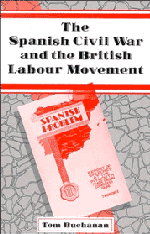Book contents
- Frontmatter
- Contents
- Preface
- List of abbreviations
- Introduction: ‘The Spanish problem’
- 1 ‘The best that could be done at the time…’: Non-Intervention, 17 July–28 October 1936
- 2 Breaking with Non-Intervention: October 1936–October 1937
- 3 The failure of the left: October 1937–April 1939
- 4 ‘A demonstration of solidarity and sympathy…': The Spanish Workers' Fund and its competitors
- 5 Opposition: Catholic workers and the Spanish Civil War
- 6 Rank-and-file initiatives
- Aftermath and conclusion
- Bibliography
- Index
2 - Breaking with Non-Intervention: October 1936–October 1937
Published online by Cambridge University Press: 05 January 2012
- Frontmatter
- Contents
- Preface
- List of abbreviations
- Introduction: ‘The Spanish problem’
- 1 ‘The best that could be done at the time…’: Non-Intervention, 17 July–28 October 1936
- 2 Breaking with Non-Intervention: October 1936–October 1937
- 3 The failure of the left: October 1937–April 1939
- 4 ‘A demonstration of solidarity and sympathy…': The Spanish Workers' Fund and its competitors
- 5 Opposition: Catholic workers and the Spanish Civil War
- 6 Rank-and-file initiatives
- Aftermath and conclusion
- Bibliography
- Index
Summary
In the autumn conferences of 1937 the British labour movement united in its rejection of Non-Intervention. The TUC Congress supported the Spanish government in its appeal to the Council of the League of Nations, with the hope that the Council would propose measures which would ‘enable the Spanish people to recover their political and territorial independence’. A month later the Labour Party conference went even further than this in instructing the NEC to launch a nation-wide campaign to compel the government to abandon Non-Intervention and to restore to the Spanish government its right both to purchase arms and to establish law and order within its borders. In a clear display of unity the TUC resolution was moved by Citrine and seconded by his erstwhile adversary from the 1936 Congress Bill Zak; the Labour Party resolution was moved by Sir Charles Trevelyan, one of the harshest opponents of official policy in Edinburgh. Yet the basis for such unity was in fact very shallow. Chapter 3 will show that these resolutions did not represent a united policy on how to proceed against Non-Intervention, while the current chapter argues that the path towards even this limited unity was much more tortuous than was admitted at the time.
Citrine had disingenuously presented the new position as a natural evolution from that adopted a year before – after all, he claimed, ‘we have never accepted the position of neutrality’.
- Type
- Chapter
- Information
- The Spanish Civil War and the British Labour Movement , pp. 73 - 106Publisher: Cambridge University PressPrint publication year: 1991



